Meta 3D Gen model can turn your ideas from text to 3D in seconds

The tech giant has recently introduced Meta 3D Gen, a special type of model that transforms simple text prompts into detailed 3D models in less than a minute.
The new research is a part of Meta’s ongoing efforts to enhance artificial intelligence capabilities, particularly in generative AI. Unlike traditional text-to-image generators, Meta 3D Gen produces fully realized 3D models complete with high-quality geometry and textures, making it an important tool for 3D asset creation.
The journey to create high-quality 3D assets has traditionally been labor-intensive and time-consuming. Artists and designers have spent countless hours sculpting models and applying textures to achieve the desired level of detail. This process often involved using multiple software tools and required a high level of expertise. The introduction of text-to-image generators simplified the creation of 2D images, but generating 3D models remained a complex task.
Meta 3D Gen changes this by leveraging advanced AI models to automate the creation of 3D assets!
 Meta 3D Gen’s results are preferred by professional 3D artists over other models (Image credit)
How does Meta 3D Gen work?
Meta 3D Gen’s results are preferred by professional 3D artists over other models (Image credit)
How does Meta 3D Gen work?
The system uses a two-stage method, combining Meta’s AssetGen and TextureGen technologies. AssetGen handles the generation of the 3D geometry, while TextureGen focuses on applying high-resolution textures and material maps. This separation allows for greater control and iterative refinement, similar to how text-to-image generators operate.
The core of Meta 3D Gen’s functionality lies in its ability to interpret text prompts and translate them into detailed 3D models. This is done in two effective stages, as explained in the Meta 3D Gen research paper:
- Text-to-3D generation
- Text-to-texture generation
The magic of the new tool starts with a simple text. When a user inputs a text prompt, Meta 3D Gen’s AI model generates a 3D mesh that represents the basic shape and structure described in the prompt. This initial stage focuses on creating accurate geometry that can support physically-based rendering (PBR).
Once the 3D mesh is created, the system applies high-resolution textures and material maps. This process enhances the visual fidelity of the model, making it suitable for real-world applications. Users can adjust the texture style by modifying the input text, allowing for easy customization without altering the underlying mesh.
 The technology can be used in various industries (Image credit)
The technology can be used in various industries (Image credit)
As you can see, the results do not look very realistic. However, with a small lightning adjustment, these llama models can look very stylish and sweet.
Meta’s approach ensures that the final output is of high quality and can be used in various modeling and rendering scenarios. According to Meta’s research, 3D Gen’s results are preferred by professional 3D artists over other text to 3D model generators, and the process is significantly faster, often taking less than a minute.
Where can it truly shine?Meta 3D Gen’s ability to quickly generate high-quality 3D models opens up numerous possibilities across different industries, such as:
- Game developers and animators can use Meta 3D Gen to create detailed characters, environments, and props quickly.
- Creating immersive VR and AR experiences requires a large number of high-quality 3D assets. Meta 3D Gen can streamline this process, making it easier to develop interactive and engaging virtual environments.
- Designers can use Meta 3D Gen to quickly visualize product concepts and iterate on designs. The ability to generate detailed 3D models from simple text prompts can accelerate the prototyping phase and improve collaboration between design teams.
As Meta 3D Gen continues to evolve, it is expected to further simplify and enhance the process of 3D asset creation. The technology’s ability to generate high-quality models quickly and accurately has the potential to transform how industries approach 3D modeling. By automating much of the manual work, Meta 3D Gen allows artists and designers to focus on creativity and innovation.
Meta’s ongoing research and development in generative Meta AI are likely to lead to even more advanced capabilities in the future. For now, Meta 3D Gen stands as a powerful tool that can improve efficiency and productivity in 3D asset creation.
Featured image credit: upklyak/Freepik
